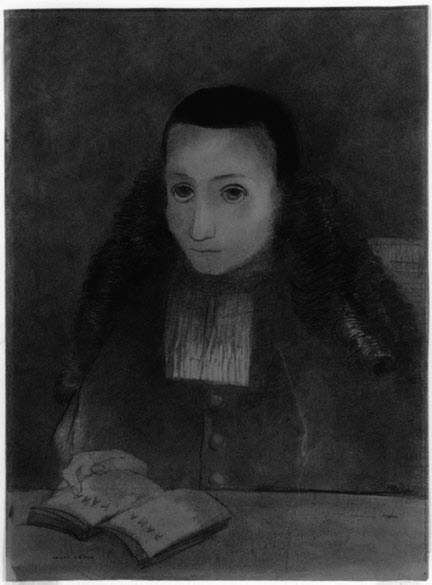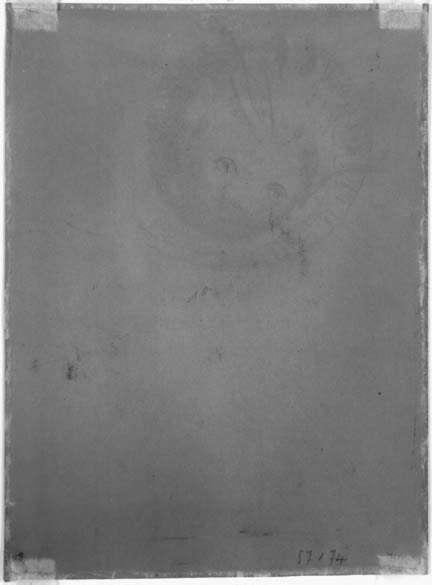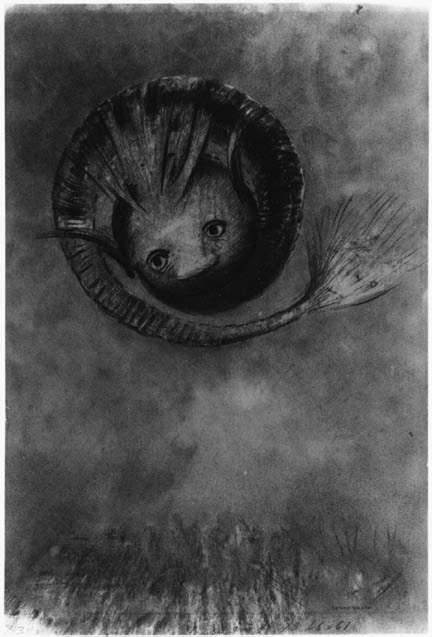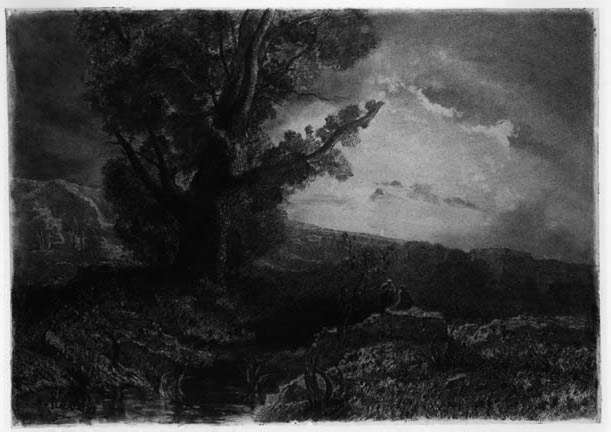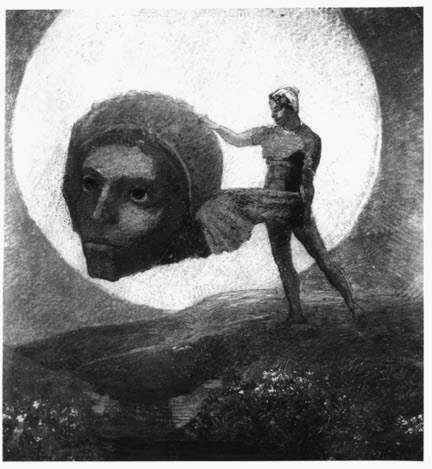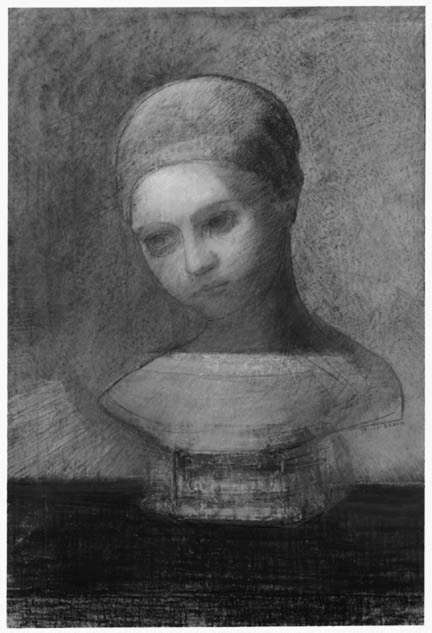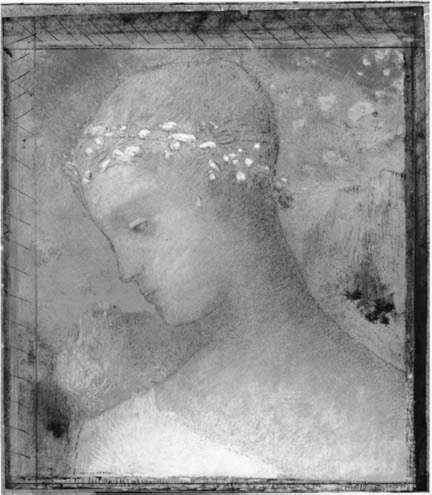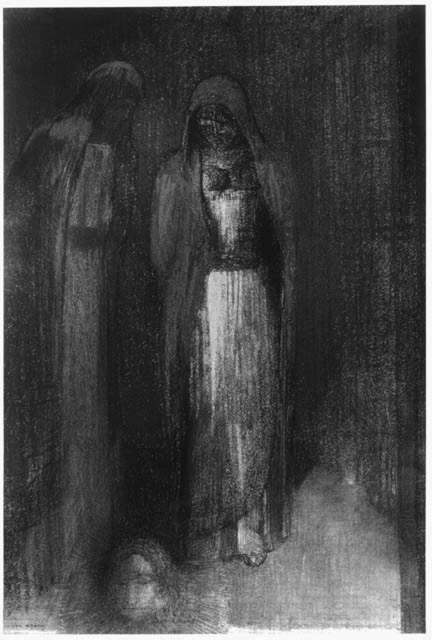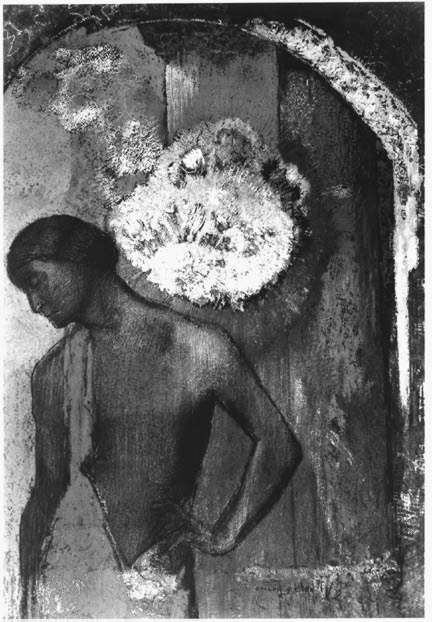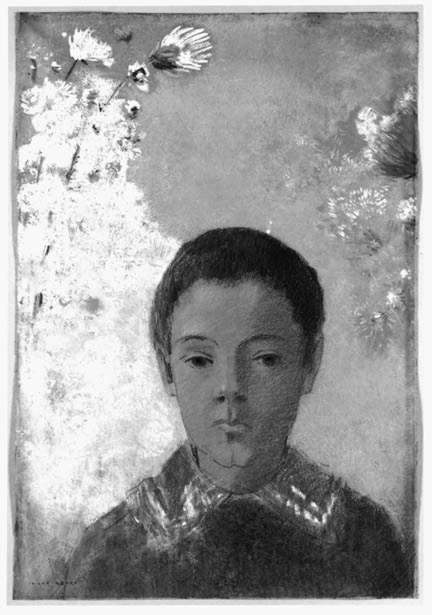A Technical Investigation of Odilon Redon's Pastels and Noirs
by Harriet K. StratisIntroduction
Research on the materials and techniques used by Odilon Redon (1840-1916) to create his works of art on paper was carried out over a four-year period. The aim was to gather information for the retrospective exhibition held at the Art Institute of Chicago, the Van Gogh Museum in Amsterdam and the Royal Academy of Arts in London. This information was published in the accompanying exhibition catalogue and also informed our request for loans of works on paper.1 In view of the fact that the majority of Redon's works are undated, the investigation focused in part on how Redon modified his methods and materials over the course of his career in order to see whether there was a pattern in the artist's technical evolution which could provide a framework for dating many of his drawings. Equally important in terms of the retrospective was whether the artist's use of materials has resulted in works which, today, are sufficiently stable to warrant responsible requests for exhibition loan.
The research began with the study of a large body of works on paper by Redon in Chicago collections. Thirty-three black and white drawings known as his noirs and nine pastels were examined exhaustively; samples of media, paper fibers and fixative were taken from works spanning all periods of the artist's career for identification. Thereafter, over three hundred works in both public and private collections in the United States, Europe and the United Kingdom were studied in light of the findings made in Chicago. It was particularly fortunate to have the opportunity to examine many of these works under the same conditions as those in Chicago: that is, out of their frames and under magnification. At many institutions this proved advantageous insofar as it offered the opportunity to examine both the recto and the verso of many drawings, and permitted the testing of media for stability. These finding informed the study of works which could not be examined under such ideal circumstances.
As a result of this investigation, new information has come to light regarding the artist's choice of papers, his drawing media, and the fixative he used to secure the media to the paper. Previously, undated drawings could not be unequivocally linked to specific moments in the artist's career. Now, based on changes of pattern in the artist's use of materials and techniques a clearer picture of his development has emerged. Moreover, the findings have proven that many of Redon's works on paper are much more stable than traditionally thought to be, reflecting Redon's own concerns about the potential fragility of the media in which he worked.
Media and Fixative--The Noirs
The materials used by Redon to create his noirs changed during the course of his career as he became increasingly aware of the variety of black drawing media available to him. In the earliest noirs Redon used a combination of vine and oiled charcoal with touches of compressed charcoal. He would also use black crayon, most likely conté crayon, sparingly. Fabricated black chalk, a much harder and blacker medium than the various charcoals used by the artist, was introduced in the mid-to-late 1870's, at which time he also began to use compressed charcoal more extensively. He would use these harder media primarily to outline compositional elements over broad tonal passages of charcoal. After the mid-1880s, black pastel appears with increased frequency in the noirs, its presence signaled by a cool, blue-black tone and velvety surface quality. Redon reserved its use for the last stages of working over grayer and browner media. As a result, lines of black pastel stand out from and are accentuated by the warmer-toned media around and beneath them.2
Fig. 1. The Little Abbot Reading the Ramayana, 1833. Various charcoals, with black chalk, stumping, scraping, and erasing on cream wove paper altered to a golden tone; 50.5 cm x 37.2 cm. The Art Institute of Chicago
Fig. 2. A faint image of Tadpole on the verso of The Little Abbot Reading the Ramayana appears in reverse of the original.
Fig. 3.Tadpole, 1883. Various charcoals, with touches of black chalk, wiping, stumping, erasing, and incising, on pink wove paper with red fibers altered to a golden tone; 48 x 34 cm. Collection State Museum Kröller-Müller, Otterlo, The Netherlands.
During the course of working, Redon intermittently fixed his drawings. As the final step in completing a work, additional fixative was spray or brush applied to the verso of a sheet. It would then saturate the sheet and assure adhesion of the media to the recto. Under magnification, the fixative invariably coats the media and the paper fibers heavily, insuring stability. In addition to insuring the stability of his drawings by the liberal use of fixative, Redon also used oiled charcoal extensively. Oiled charcoal, though often described as a medium that was sent into total oblivion by the spread of new drawing materials in the latter half of the 19th century, figures prominently in Redon's noirs. Like past artists, Redon probably made his oiled charcoal himself by soaking pieces of vine charcoal in linseed oil before drawing with them. For centuries this material was valued for its ability to adhere readily to paper fibers, whereas ordinary charcoal particles tend to sit on the paper surface remaining powdery and vulnerable to smudging. In Redon's noirs, oiled charcoal can be identified by its warmer brown-black tone, and under magnification, by the coarse particle size of the charcoal and a halo around each drawn line. Over time, as the oil is absorbed into the paper, it darkens the fibers further, and the haloing becomes more pronounced. Eventually the areas of paper covered with oiled charcoal exhibit an overall brown tone. Redon's use of oiled charcoal is supported by examination of The Little Abbot Reading the Ramayana of 1883 (Figure 1). On the verso of this drawing (Figure 2), a faint image of Tadpole, another drawing of the same date (Figure 3), appears in reverse of the original. It is obvious that this image was formed by the oil that migrated from the recto of one drawing onto the verso of the other. Under magnification, there is no evidence of offset charcoal in the image. This could only have happened if the drawings were placed in contact with each other for a period of time, and in fact they were. Sale records indicate that they were not separated until May of 1899 when both were sold to the Parisian art dealer Ambroise Vollard. In his correspondence, Redon often lamented that his drawings sat in cartons for decades and it is likely that these two works executed in the same year could have been placed together in a box, without interleaving, for many years, during which time oil migration occurred.
Fig. 4. Landscape, 1868. Various charcoals, with black chalk and black conte crayon, wiping, stumping and erasing, on cream wove paper altered to a golden tone; 53.6 x 75.5 cm. The Art Institute of Chicago
In his 1868 Landscape (Figure 4), Redon prepared the paper with an overall base of powdered charcoal. Often, his first step in the drawing process was to produce a modulated tone from which he could extract forms to establish his initial conception. Here he stumped and erased charcoal from the back and middle ground to establish the distant vistas and to provide the recession into a deep panoramic space. In the foreground, he combined stumping and erasing with the darkest applications of various charcoals and black conté crayon to set apart the monumental tree and isolate two figures in the vast setting. He ground the coarsest charcoal and applied it with a brush in an impasto-like manner that suitably describes the uncultivated terrain surrounding the figures.
Fig. 5.Tree, c. 1875. Various charcoals, stumping, scraping, and erasing, on cream wove paper altered to a golden tone; 49.3 x 38 2 cm. The Art Institute of Chicago.
Throughout the 1870's, Redon developed a more expansive repertoire of drawing techniques. He turned a rectangular stick on its side for broad tonal applications, and wetted a rounded stick with a pointed tip for linear applications. His intermittent use of fixative allowed him to expand his methods of subtraction to include incising with a pointed tool, scraping with a hard-bristled brush, and lifting of media with a sponge or his hands. In the Art Institute's Tree (Figure 5), a drawing executed in a variety of charcoals around 1875, Redon achieved an extraordinary range of manipulations. As he built the composition with layers of media, he intermittently fixed the surface and again subtracted media from it. Before the spray-applied fixative could dry, Redon reworked the damp charcoal surface with his fingers. The artist's fingerprints are clearly embedded in the background to create a modulated tone. He used his fingers to remove charcoal from the top of the tree and reapplied it to the left of this area to add foliage to several bare branches. He may have even used his fingernail to scrape away fixed media and create the delicate blades of grass in the foreground.
In all his noirs, the degree to which Redon selectively manipulated and removed his drawing materials determined how much of the underlying paper support would be visible. As a result, the paper itself became an integral tonal element in the drawings. Golden-toned papers have come to be known as those Redon preferred for his noirs. This however, is a misconception. The apparent uniformity in the artist's papers is actually the result of several conditions: the application of fixative, which darkens the sheets; exposure of the papers to light; and the inherent instability of dyestuffs used in their manufacture. In fact, Redon was quite deliberate in his choice of papers, and they do vary considerably. He used both laid and wove papers in a variety of tones, most often choosing mottled papers, in which red, blue and multi-colored fibers are visible. These colored fibers imbue the paper supports with various casts of pale pink and blue. Redon himself stated that all his noirs were made on colored papers, usually of yellow, pink and blue. He further stated that "the terminology white and black that would ordinarily be used to designate these drawings in chalk or in charcoal should not therefore be used in their classification."3
In most of the noirs, the initial paper tone remains evident over time, even though the fixative Redon applied to it has darkened and made the paper more golden in tone, as he intended. It was well known to Redon, as well as to other artists, that many resins, glues and gums became golden-yellow upon aging. Redon distinguished himself from his contemporaries by looking upon this phenomenon favorably. In an unpublished letter to Andries Bonger, his principle Dutch collector, Redon mentioned that the fixative he used for a noir acquired several years earlier by Bonger was resine. He is no more specific that this, and no other correspondence has been found in which he mentions his fixative. However, analysis of samples of the fixative taken from the noirs reveals that it contains colophony, a major component of balsam resins.4 The identification of balsams in samples taken from noirs made in the early, middle, and late stages of his career indicates the regularity with which Redon used a balsam fixative, presumable diluted in alcohol, which he then spray or brush applied in various consistencies, over several decades. The golden-toned fixative immediately imparts a slight yellow tone to the paper, and over a short period of time, with exposure to light, the balsam darkens further. Redon certainly must have been aware from the outset that his fixative would alter the appearance of his drawings. He retained many of them for decades, which provided him with ample opportunity to witness their aging and to decide to forego the use of balsam if he had not found these color changes desirable.
Media and Fixative--The Pastels
Fig. 6. Figure Holding a Winged Head, c. 1876. Pastel and gouache, over charcoal and traces of graphite, on cream wove paper altered to a golden tone; 48 x 44.5 cm. Collection of a private foundation, Baltimore.
Fig. 7.Small Bust of a Young Girl, 1884. Pastel, with touches of gouache and black and colored conté crayon, over traces of charcoal, on tan wove paper altered to a golden tone; 45.3 x 31.8 cm. Private collection, Canada.
Fig. 8.Beatrice, 1885. Pastel, with touches of incising, over traces of charcoal, on tan wove paper, laid down on board; 34.5 x 30 cm. Private collection.
Redon's shift to color can be traced over three decades, but it was not until after 1890 that the artist devoted himself to working extensively in the pastel medium. His techniques in his early pastels of the 1870s and 80s differ significantly enough from those he employed after 1893, and from those he used after 1912, to provide a general framework for dating a number of works in this medium. In his earliest pastels, Redon applied color over charcoal underdrawings, combining pastel, gouache and pastes made from crushed pastel mixed with water and applied with a brush. One of his earliest fully realized works in the medium is Figure Holding a Winged Head, which dates stylistically to about 1876 (Figure 6). Here the artist applied the pastel in single, short strokes, with little attempt to blend, stump, or soften the lines into one another or into adjacent areas of color. He also layered red and yellow gouache over and under the pastel, and together they form patterns of parallel and crossed lines throughout. As in all of the early pastels, the surface of this sheet has a lustrous quality that Redon created by heavily coating the media with his resinous fixative. In two sheets from nearly a decade later, Small Bust of a Young Girl (Figure 7) and Beatrice, (Figure 8), both in private collections, Redon's working methods are virtually identical to those used ten years before.
Fig. 9.Salome, c. 1893. Pastel, with touches of graphite, over charcoal and black chalk, on tan wove paper; 58.9 x 40.1 cm. Kunsthandel Wolfgang Werner KG, Bremen.
On occasion Redon would take up a noir he produced years earlier and entirely rework it, obscuring much of the noir beneath pastel. Yet he would often leave passages within the compositions that revealed the origins of these works. Salome, a pastel from around 1893 (Figure 9), exhibits a radical reworking of the underlying noir. As originally conceived, a lone female figure centered within an architectural setting casts her eyes down onto a severed head. When Redon reworked the noir in pastel, he added a second female figure to Salome's right, transforming the composition into a mystical conversation of sorts although the severed head remains. This makes the reading of the drawing deliberately ambiguous.
Fig. 10.Sita, c. 1893. Pastel, with touches of black conté crayon, over various charcoals, on cream wove paper altered to a golden tone; 53.6 x 37.7 cm. The Art Institute of Chicago.
Fig. 11.Saint John, 1892. Pastel, over charcoal, on tan wove paper; 42.5 x 29 cm. Private collection, courtesy of Marc de Montebello, New York.
During the early 1890's, Redon often treated the fully developed noir as a monochromatic base for pastel in much the same way as painters used a monochromatic palette to create an underpainting in a limited range of earth tones. This practice was not limited to painting, as Redon was no doubt aware. Fantin-Latour treated some of his lithographs printed in black as bases for pastel, and Degas did the same with faint second impressions of his monotypes. What distinguishes Redon's method in the small number of pastels that he produced during this period is the extent to which he painstakingly created accomplished noirs, complete with stumping, erasing and incising, which he then obscured with color. He employed a pastel palette with an ever-increasing range of vibrant colors, not to alter compositions as before, but to imbue them with color. In Sita, c. 1893 (Figure10), Redon concealed the noir with layers of pastel, except within the oval that appears to the left of Sita as a narrative element in the drawing. Here he partially reveals the black media and golden-toned paper of the noir. In Saint John, a pastel of 1892 (Figure 11), the manner in which Redon used pastel to create a chromatic composition similarly relied upon the underlying noir to sustain a cohesive composition, although ultimately the noir was almost completely covered beneath layers of pastel.
Fig. 12.Portrait of Ari Redon, c. 1898. Pastel on pale blue wove paper faded to gray; 44.8 x 30.8 cm. The Art Institute of Chicago.
Fig. 13.Flower Clouds, c. 1903. Pastel, with touches of stumping, incising, and brushwork, on blue-gray wove paper with multi-colored fibers faded to tan, perimeter mounted to cardboard; 44.5 x 54.2 cm. The Art Institute of Chicago.
Later in the 1890's Redon began relying less and less on charcoal underdrawings and noirs, and as he became more accustomed to working with pastel, he abandoned their use altogether. His manipulations of the medium expanded. Often he wetted the end of a pastel stick to produce strokes that had an impasto-like quality and were thicker, denser and less powdery than unwetted pastel. In his Portrait of Ari Redon, c. 1898 (Figure 12), the artist used this technique to draw the white, blue and yellow petals of the flowers behind his young son. In numerous compositions Redon used hard, soft, pointed and blunt sticks of pastel. In still lifes, he frequently added black conté crayon and graphite over the pastel to outline individual flowers and add details to petals and leaves. In portraiture he used colored conté crayons and graphite to delineate facial features. In other works Redon alternated layers of pastel with sprayed fixative, working each layer by wiping or brushing the pastels into each other to develop rich velvety surfaces. Networks of brush strokes are evident throughout many. In Flower Clouds, c. 1903 (Figure 13), the entire background is composed of striations and brush strokes of pastel. Once he fixed these passages, Redon incised and further manipulated them with a brush to selectively uncover the underlying pastel colors.
Initially Redon adapted the fixing techniques for his noirs to his pastels seemingly disregarding that the fixative would saturate the pastel particles and significantly alter their color and surface quality. Many artists struggled with this issue throughout the 19th century in an attempt to balance the retention of the color and surface quality of the pastels with the necessity of fixing the fragile medium to prevent it from dislodging and smudging. Redon slowly learned to apply less fixative to his pastels, and he even changed the type he used from a resinous balsam to a glue-based fixative that did not alter the vivid color and velvety, matte surface quality as significantly.5 After the turn of the century, Redon gradually decreased his use of fixative in his pastels. Where he created more than one layer of pastel in a composition, Redon did intermittently fix the underlayers to facilitate application of additional pastel. Yet, in these works, Redon often did not fix the uppermost layer of pastel, presumably because he did not want the intensity of his colors to be compromised. In the majority of works produced after 1912, Redon used virtually no fixative at all.
Conclusion
The examination of Redon's noirs and pastels in a large number of public and private collections in the United States and abroad has established the consistency with which the artist created his works of art on paper and the materials he used to do so. Even subtle modifications in Redon's drawing materials, papers and techniques during the course of his career have allowed us to date many of the undated noirs and some of the pastels by technical comparison with securely dated works. Also, by examining each drawing firsthand, we were able to make informed, conscientious loan requests. As noted throughout, Redon's fixing of his noirs was integral to his working process. Not one noir has been identified devoid of fixative to date, and based on these findings there is no reason to believe that a body of work executed in unfixed black friable media will be found. On the other hand, the use of fixative with the pastel medium was less consistent and towards the end of his career Redon seems to have abandoned its use all together. For this reason, examination of pastels on a case-by case basis for the presence of fixative and overall stability is imperative.
Acknowledgments
I am grateful to the many conservators who welcomed me into their laboratories to more closely examine Redon's works unframed and under magnification; my colleagues Douglas Druick, Kevin Sharp, and Peter Zegers in the Department of Prints and Drawings at The Art Institute of Chicago for their insightful comments and suggestions; and the National Endowment for the Arts and the Samuel H. Kress Foundation for their generous support of this project.
Notes
1. This paper represents a partial summary of recently published research. See Harriet K. Stratis, "Beneath the Surface, Redon's Methods and Materials," in Odilon Redon, Prince of Dreams 1840-1916, exh. cat. ed. by Douglas W. Druick (1994), pp. 353-377, pp. 427-431, for the more comprehensive study.
2. For detailed studies of black drawing materials, see Joseph Meder, The Mastery of Drawing, rev. and trans. by Winslow Ames (New York, 1978), esp. chap. 4, "Broad-Line Media"; James Watrous, The Craft of Old Master Drawings (Madison, Wis., 1957); Vojtech and Thea Jirat-Wasiutynski, "The Uses of Charcoal in Drawing," Arts Magazine (1980), pp. 128-35. Known samples of black drawing materials, including oiled charcoal, in Joseph Meder's Die Handzeichnung. Ihre Technik und Entwicklung (Vienna, 1923), "Abb. 51 - Originale Strichproben," were used as a basis for comparison with the various black drawing media found in Redon's noirs.
3. The unpublished papers of André Mellerio and Odilon Redon in the collection of the Ryerson Library at The Art Institute of Chicago contain a Catalogue of the Noirs; this statement appears on the verso of p. 1.
4. I am grateful to Dr. Peter J. Zanzucchi (David Sarnoff Research Center, Princeton, NJ) for carrying out infrared spectroscopic analysis of several samples of fixative taken from Redon's noirs. His analysis was the first to identify the material as a natural resin. I am also grateful to Michael R. Schilling, Michele Derrick, and Dusan Stulik (The Getty Conservation Institute) for pursuing this analysis further by carrying out diterpenoid resin analysis. They detected colophony, a major component of balsam resins, in the acetone extracts of fixative samples taken from the noirs using gas chromatography-mass spectrometry-selected ion monitoring (GC-MS-SIM) analysis of the silylated derivatives. A Hewlett Packard GC-MS system, comprised of an HP 5890 Series II gas chromatograph and an HP 5988A mass spectrometer, was used for the separation and identification of the volatile sample components.
5. Dr. Peter J. Zanzucchi carried out infrared spectroscopic analysis of several samples of fixative taken from Redon's pastels. His analysis was the first to identify it as a proteinaceous material. Michael R. Schilling, Michele Derrick, and Dusan Stulik pursued this analysis further. They identified animal glue in the fixative samples taken from the pastels, based on amino acid profiles, using gas chromatography-flame ionization detection (GC-FID) of the ECF-derivatives of the protein hydrolysate. A Hewlett Packard GC system, consisting of an HP 5890 gas chromatograph with flame ionization detection, was used for separation and identification of the volatile sample components. Identification of animal glue was based upon the presence of significant levels of hydroxyproline.
Harriet K. Stratis
Conservator of Prints and Drawings
The Art Institute of Chicago
Publication History
Received: Fall 1995
Paper delivered at the Book and Paper specialty group session, AIC 23th Annual Meeting, June 4-1, 1995, St. Paul, Minnesota.
Papers for the specialty group session are selected by committee, based on abstracts and there has been no further peer review. Papers are received by the compiler in the Fall following the meeting and the author is welcome to make revisions, minor or major.
